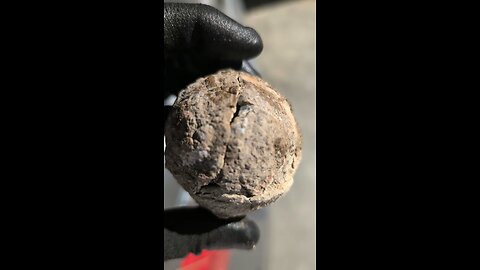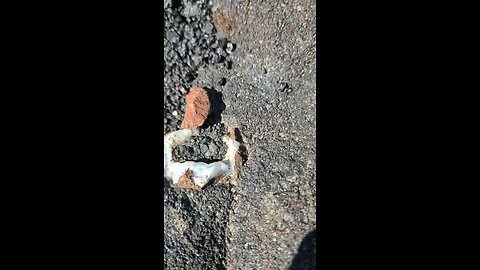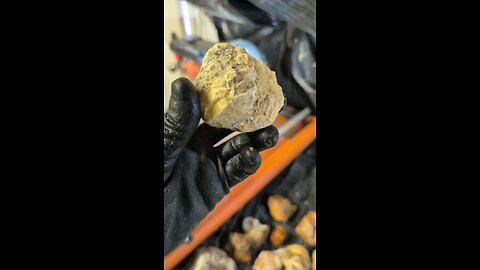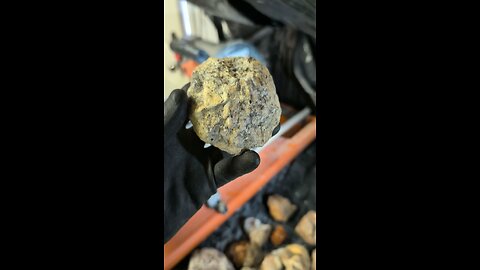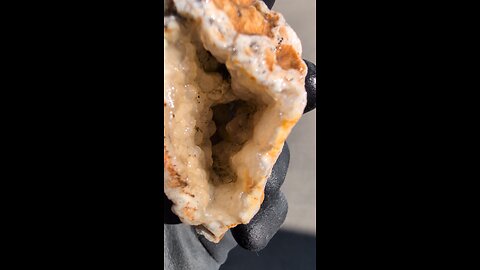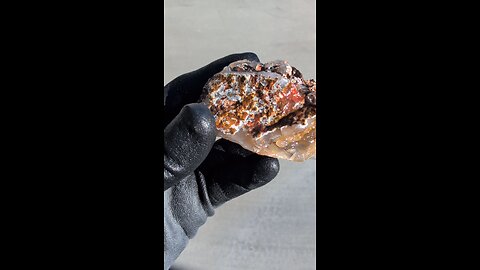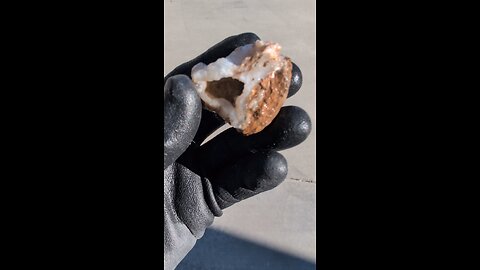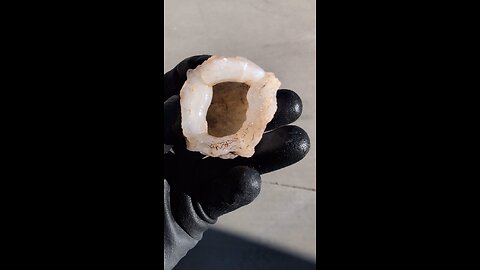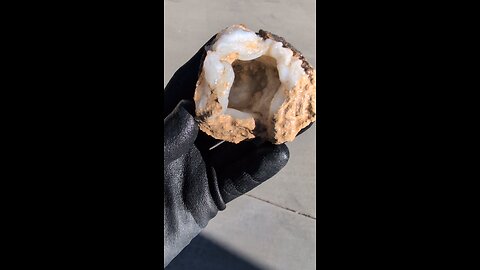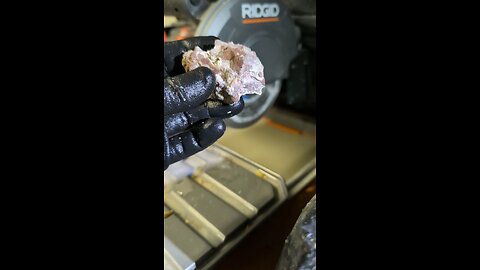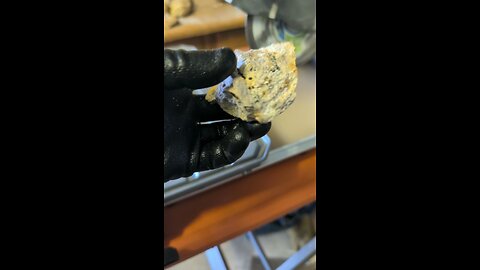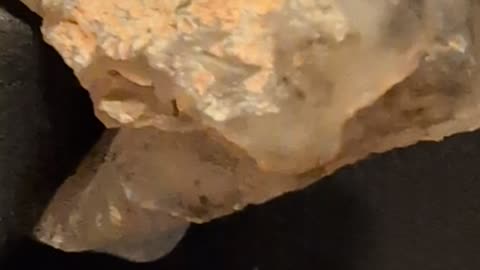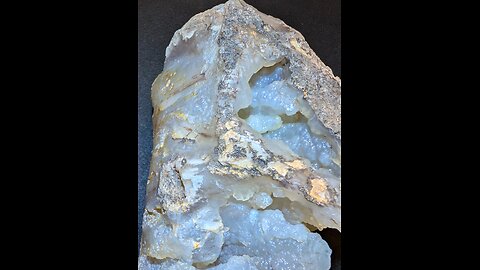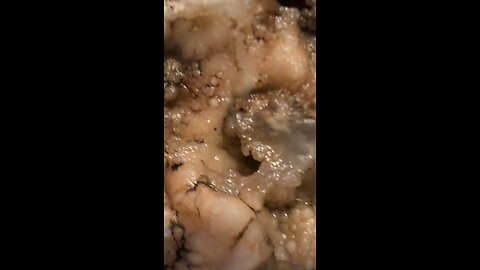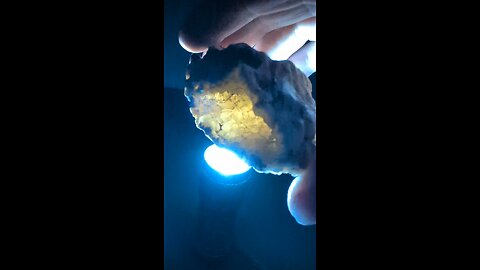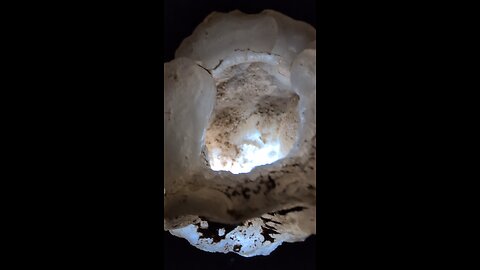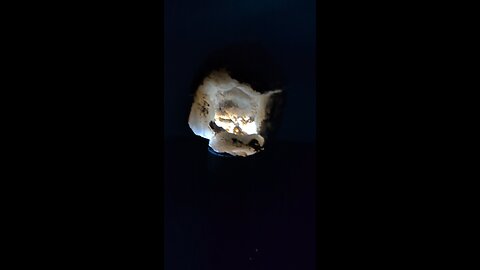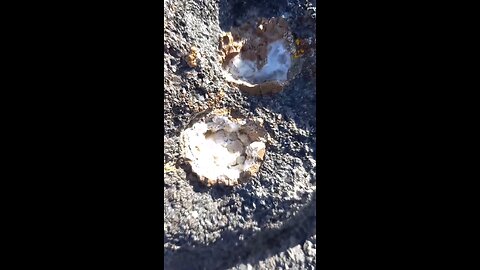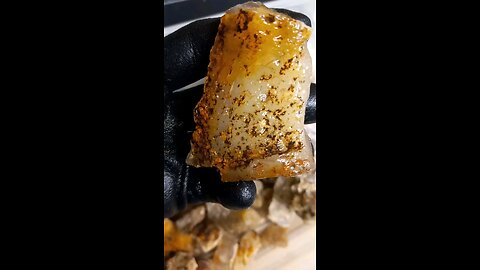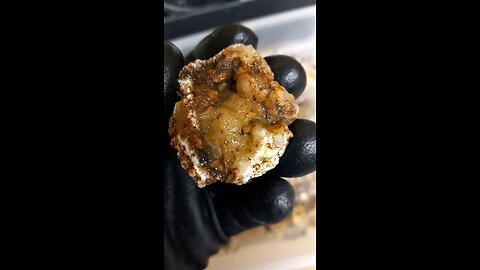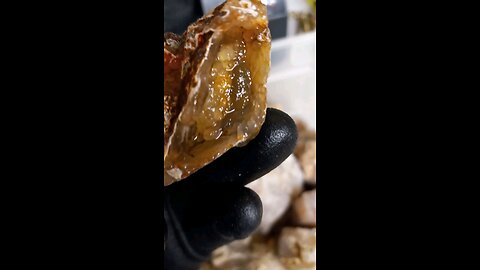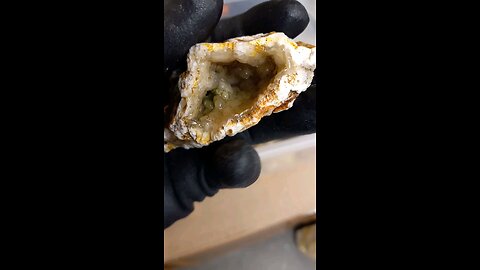Premium Only Content
This video is only available to Rumble Premium subscribers. Subscribe to
enjoy exclusive content and ad-free viewing.

Geodes!
HumbleConservative
- 23 / 25
1
Whole & Broken Geodes!
HumbleConservative
A geode is a hollow, usually spherical rock, that when broken open reveals a cavity lined with crystals or other mineral formations. Here are some key points about geodes:
Formation: Geodes form when gas bubbles or cavities in volcanic or sedimentary rock are filled with mineral-rich water. As the water evaporates, it leaves behind minerals which crystallize over time, lining the inside of the cavity.
Structure: The outer layer of a geode is typically rough and nondescript, often making it look like an ordinary rock until it's cracked open. Inside, you might find crystals like quartz, amethyst, calcite, or even rarer minerals.
Location: They are commonly found in regions with volcanic activity or limestone deposits. Famous locations include parts of the United States, Brazil, Uruguay, and Mexico.
Uses: Geodes are popular among rock collectors and are often cut and polished for use in jewelry or as decorative pieces. Some are also used in metaphysical practices for their supposed healing properties.
Identification: To identify a geode, one would typically look for a rock that is unusually light for its size or has a hollow sound when tapped. However, the only definitive way to confirm is by breaking it open or using specialized equipment like X-rays.
If you're interested in finding or identifying geodes, or if you have any other questions about them, feel free to ask!Rabbit Springs Geode Field, is a well-known rockhounding site located in southern Idaho near the Nevada border. It’s a popular spot for collectors seeking thundereggs—spherical rocks that often contain beautiful agate or crystal-filled centers, some of which fluoresce under UV light due to mineral content like chalcedony or quartz.
2
Geode Field!
HumbleConservative
Rabbit Springs Geode Field, also known as Rabbit Springs Thundereggs, is a well-known rockhounding site located in southern Idaho near the Nevada border. It’s a popular spot for collectors seeking thundereggs—spherical rocks that often contain beautiful agate or crystal-filled centers, some of which fluoresce under UV light due to mineral content like chalcedony or quartz. This site sits along U.S. Highway 93, roughly 38 miles from Twin Falls, Idaho, and about 130 miles from Mountain Home, making it accessible yet remote enough to feel like a true adventure.
The coordinates for Rabbit Springs are approximately 42.06572°N, -114.67387°W. You can get there by driving south from Twin Falls toward Jackpot, Nevada, and looking for the old Rabbit Springs rest area, a historical marker for the site. The terrain is rugged, typical of the high desert landscape in this region, with volcanic and sedimentary rocks from ancient geological activity providing the perfect conditions for thunderegg formation. These rocks are remnants of gas pockets in lava flows that filled with silica-rich fluids over millions of years.
No heavy digging is necessary here—surface collecting with a bucket is the way to go, as many thundereggs are weathered out and scattered across the ground. A rock hammer might come in handy to crack them open, but locals and seasoned rockhounds suggest the best finds are often already exposed, and breaking into the bedrock isn’t worth the effort. The thundereggs vary in size, from plums to grapefruits, and some glow a striking green or orange under a 365nm UV light, thanks to trace minerals. Rumors of radioactivity have floated around, but tests with Geiger counters have debunked that myth.
The site is on public land managed by the Bureau of Land Management (BLM), so casual collecting is allowed as long as you’re not using heavy machinery or digging extensive tunnels—stick to hand tools and surface finds. Any vehicle can make the trip, though the final approach might involve a short walk from the highway. September’s cooler weather makes it an ideal time to visit, avoiding the summer heat of this arid region.
3
Snowball geode!
HumbleConservative
A geode is a hollow, usually spherical rock, that when broken open reveals a cavity lined with crystals or other mineral formations. Here are some key points about geodes:
Formation: Geodes form when gas bubbles or cavities in volcanic or sedimentary rock are filled with mineral-rich water. As the water evaporates, it leaves behind minerals which crystallize over time, lining the inside of the cavity.
Structure: The outer layer of a geode is typically rough and nondescript, often making it look like an ordinary rock until it's cracked open. Inside, you might find crystals like quartz, amethyst, calcite, or even rarer minerals.
Location: They are commonly found in regions with volcanic activity or limestone deposits. Famous locations include parts of the United States, Brazil, Uruguay, and Mexico.
Uses: Geodes are popular among rock collectors and are often cut and polished for use in jewelry or as decorative pieces. Some are also used in metaphysical practices for their supposed healing properties.
Identification: To identify a geode, one would typically look for a rock that is unusually light for its size or has a hollow sound when tapped. However, the only definitive way to confirm is by breaking it open or using specialized equipment like X-rays.
4
Ice Ice Baby!
HumbleConservative
A geode is a hollow, usually spherical rock, that when broken open reveals a cavity lined with crystals or other mineral formations. Here are some key points about geodes:
Formation: Geodes form when gas bubbles or cavities in volcanic or sedimentary rock are filled with mineral-rich water. As the water evaporates, it leaves behind minerals which crystallize over time, lining the inside of the cavity.
Structure: The outer layer of a geode is typically rough and nondescript, often making it look like an ordinary rock until it's cracked open. Inside, you might find crystals like quartz, amethyst, calcite, or even rarer minerals.
Location: They are commonly found in regions with volcanic activity or limestone deposits. Famous locations include parts of the United States, Brazil, Uruguay, and Mexico.
Uses: Geodes are popular among rock collectors and are often cut and polished for use in jewelry or as decorative pieces. Some are also used in metaphysical practices for their supposed healing properties.
Identification: To identify a geode, one would typically look for a rock that is unusually light for its size or has a hollow sound when tapped. However, the only definitive way to confirm is by breaking it open or using specialized equipment like X-rays.
5
Botryoidal Geode!
HumbleConservative
A geode is a hollow, usually spherical rock, that when broken open reveals a cavity lined with crystals or other mineral formations. Here are some key points about geodes:
Formation: Geodes form when gas bubbles or cavities in volcanic or sedimentary rock are filled with mineral-rich water. As the water evaporates, it leaves behind minerals which crystallize over time, lining the inside of the cavity.
Structure: The outer layer of a geode is typically rough and nondescript, often making it look like an ordinary rock until it's cracked open. Inside, you might find crystals like quartz, amethyst, calcite, or even rarer minerals.
Location: They are commonly found in regions with volcanic activity or limestone deposits. Famous locations include parts of the United States, Brazil, Uruguay, and Mexico.
Uses: Geodes are popular among rock collectors and are often cut and polished for use in jewelry or as decorative pieces. Some are also used in metaphysical practices for their supposed healing properties.
6
Botryoidal Plume Agate!
HumbleConservative
A botryoidal formation refers to a mineral structure that resembles a cluster of grapes or small, rounded, and knobby protrusions. Here are some details about botryoidal formations:
Characteristics:
Shape: The term "botryoidal" comes from the Greek word "botryoeides," meaning "grape-like." These formations have a surface that looks like a bunch of grapes.
Texture: They typically have a smooth, rounded surface, which can sometimes be polished to enhance their appearance.
Formation:
Process: Botryoidal formations occur when minerals precipitate from solution in a manner that favors the growth of rounded, nodular shapes. This often happens in cavities or vugs where mineral-rich fluids slowly deposit layers over time.
Common Minerals: Minerals that commonly form botryoidal structures include:
Hematite: Often found in botryoidal forms, giving a shiny, metallic luster.
Malachite: Known for its vibrant green color in botryoidal formations.
Goethite: Can exhibit botryoidal textures, often with a brownish to yellowi
7
Chalcedony Geode!
HumbleConservative
A geode is a hollow, usually spherical rock, that when broken open reveals a cavity lined with crystals or other mineral formations. Here are some key points about geodes:
Formation: Geodes form when gas bubbles or cavities in volcanic or sedimentary rock are filled with mineral-rich water. As the water evaporates, it leaves behind minerals which crystallize over time, lining the inside of the cavity.
Structure: The outer layer of a geode is typically rough and nondescript, often making it look like an ordinary rock until it's cracked open. Inside, you might find crystals like quartz, amethyst, calcite, or even rarer minerals.
Location: They are commonly found in regions with volcanic activity or limestone deposits. Famous locations include parts of the United States, Brazil, Uruguay, and Mexico.
Uses: Geodes are popular among rock collectors and are often cut and polished for use in jewelry or as decorative pieces. Some are also used in metaphysical practices for their supposed healing properties.
Identific
8
Geode Shot Glass!
HumbleConservative
A geode is a hollow, usually spherical rock, that when broken open reveals a cavity lined with crystals or other mineral formations. Here are some key points about geodes:
Formation: Geodes form when gas bubbles or cavities in volcanic or sedimentary rock are filled with mineral-rich water. As the water evaporates, it leaves behind minerals which crystallize over time, lining the inside of the cavity.
Structure: The outer layer of a geode is typically rough and nondescript, often making it look like an ordinary rock until it's cracked open. Inside, you might find crystals like quartz, amethyst, calcite, or even rarer minerals.
Location: They are commonly found in regions with volcanic activity or limestone deposits. Famous locations include parts of the United States, Brazil, Uruguay, and Mexico.
Uses: Geodes are popular among rock collectors and are often cut and polished for use in jewelry or as decorative pieces. Some are also used in metaphysical practices for their supposed healing properties.
Identification: To identify a geode, one would typically look for a rock that is unusually light for its size or has a hollow sound when tapped. However, the only definitive way to confirm is by breaking it open or using specialized equipment like X-rays.
9
Chalcedony Geode w/opal!
HumbleConservative
A geode is a hollow, usually spherical rock, that when broken open reveals a cavity lined with crystals or other mineral formations. Here are some key points about geodes:
Formation: Geodes form when gas bubbles or cavities in volcanic or sedimentary rock are filled with mineral-rich water. As the water evaporates, it leaves behind minerals which crystallize over time, lining the inside of the cavity.
Structure: The outer layer of a geode is typically rough and nondescript, often making it look like an ordinary rock until it's cracked open. Inside, you might find crystals like quartz, amethyst, calcite, or even rarer minerals.
Location: They are commonly found in regions with volcanic activity or limestone deposits. Famous locations include parts of the United States, Brazil, Uruguay, and Mexico.
Uses: Geodes are popular among rock collectors and are often cut and polished for use in jewelry or as decorative pieces. Some are also used in metaphysical practices for their supposed healing properties.
Identification: To identify a geode, one would typically look for a rock that is unusually light for its size or has a hollow sound when tapped. However, the only definitive way to confirm is by breaking it open or using specialized equipment like X-rays.
10
Geode Cut!
HumbleConservative
The formation of geodes begins with volcanic or sedimentary activity. In volcanic regions, geodes are often formed from the gas bubbles in lava flows. As the lava cools and hardens, these gas bubbles become cavities within the rock. Over time, mineral-rich groundwater seeps into these cavities, carrying dissolved minerals such as quartz, amethyst, calcite, or agate. As the water evaporates, the minerals are left behind, gradually lining the interior of the geode with crystals.
In sedimentary environments, geodes are formed through a different process. They typically originate in ancient limestone or shale beds. As water flows through these porous rocks, it carries minerals in solution. When the water enters a cavity or an empty space, such as a pre-existing animal burrow or a hollowed-out tree trunk, it can deposit the dissolved minerals, forming crystals inside the cavity. Over time, these crystals grow and develop into the characteristic interior of a geode.
The type of minerals found inside a geode depends on the specific geological conditions of its formation. Some geodes are filled with a single type of crystal, such as quartz or amethyst, while others exhibit a variety of minerals, creating a stunning array of colors and textures.
11
Geode Cut!
HumbleConservative
The formation of geodes begins with volcanic or sedimentary activity. In volcanic regions, geodes are often formed from the gas bubbles in lava flows. As the lava cools and hardens, these gas bubbles become cavities within the rock. Over time, mineral-rich groundwater seeps into these cavities, carrying dissolved minerals such as quartz, amethyst, calcite, or agate. As the water evaporates, the minerals are left behind, gradually lining the interior of the geode with crystals.
In sedimentary environments, geodes are formed through a different process. They typically originate in ancient limestone or shale beds. As water flows through these porous rocks, it carries minerals in solution. When the water enters a cavity or an empty space, such as a pre-existing animal burrow or a hollowed-out tree trunk, it can deposit the dissolved minerals, forming crystals inside the cavity. Over time, these crystals grow and develop into the characteristic interior of a geode.
The type of minerals found inside a geode depends on the specific geological conditions of its formation. Some geodes are filled with a single type of crystal, such as quartz or amethyst, while others exhibit a variety of minerals, creating a stunning array of colors and textures.
12
Plume botryoidal chalcedony nugget!
HumbleConservative
Plume Agate is a captivating variety of agate, renowned for its intricate and delicate feather-like inclusions. These mesmerizing formations resemble ethereal plumes or wisps suspended within the stone, creating a stunning visual effect. It belongs to the chalcedony family, characterized by its microcrystalline structure and vibrant colors.
Plume Agate derives its name from the feathery patterns that adorn its surface. These patterns are typically composed of mineral deposits, often in striking hues such as white, cream, pink, or red, contrasting against a translucent or opaque background. These intricate formations are formed through the slow crystallization of silica-rich solutions within cavities or fissures in volcanic rocks.
Each piece of Plume Agate is unique, showcasing a kaleidoscope of colors and patterns. The delicate plumes within the stone evoke a sense of tranquility and beauty, making it a highly sought-after gemstone among collectors and jewelry enthusiasts alike.
Plume Agate holds significant importance in the world of gemstones and jewelry for several reasons:
Aesthetic Appeal: Plume Agate’s captivating patterns and vibrant colors make it a favorite among jewelry designers and collectors. Its unique beauty adds an element of elegance and individuality to any piece of jewelry.
Metaphysical Properties: In addition to its visual allure, Plume Agate is believed to possess metaphysical properties that promote harmony, balance, and emotional healing. It is often used in alternative healing practices and spiritual rituals.
Collectibility: Due to its rarity and unique characteristics, Plume Agate is highly prized by gemstone collectors. Specimens with exceptional plume formations or intense colors can command high prices in the market.
Versatility: Plume Agate’s diverse color palette and patterns make it a versatile gemstone for jewelry design. It can be fashioned into various shapes and sizes, including cabochons, beads, and carvings, allowing for creativity and innovation in jewelry making.
Historical Significance: Throughout history, agates have been revered for their beauty and perceived mystical properties. Plume Agate, with its distinct plume-like inclusions, has been admired and utilized in adornments and talismans by ancient civilizations.
Plume Agate stands out as a gemstone of exceptional beauty, imbued with both aesthetic and metaphysical significance. Its popularity in the world of gemstones and jewelry continues to endure, captivating admirers with its mesmerizing patterns and timeless allure.
- https://geologyscience.com/gemstone/plume-agate/
13
Botryoidal slice!
HumbleConservative
Plume Agate is a captivating variety of agate, renowned for its intricate and delicate feather-like inclusions. These mesmerizing formations resemble ethereal plumes or wisps suspended within the stone, creating a stunning visual effect. It belongs to the chalcedony family, characterized by its microcrystalline structure and vibrant colors.
Plume Agate derives its name from the feathery patterns that adorn its surface. These patterns are typically composed of mineral deposits, often in striking hues such as white, cream, pink, or red, contrasting against a translucent or opaque background. These intricate formations are formed through the slow crystallization of silica-rich solutions within cavities or fissures in volcanic rocks.
Each piece of Plume Agate is unique, showcasing a kaleidoscope of colors and patterns. The delicate plumes within the stone evoke a sense of tranquility and beauty, making it a highly sought-after gemstone among collectors and jewelry enthusiasts alike.
Plume Agate holds significant importance in the world of gemstones and jewelry for several reasons:
Aesthetic Appeal: Plume Agate’s captivating patterns and vibrant colors make it a favorite among jewelry designers and collectors. Its unique beauty adds an element of elegance and individuality to any piece of jewelry.
Metaphysical Properties: In addition to its visual allure, Plume Agate is believed to possess metaphysical properties that promote harmony, balance, and emotional healing. It is often used in alternative healing practices and spiritual rituals.
Collectibility: Due to its rarity and unique characteristics, Plume Agate is highly prized by gemstone collectors. Specimens with exceptional plume formations or intense colors can command high prices in the market.
Versatility: Plume Agate’s diverse color palette and patterns make it a versatile gemstone for jewelry design. It can be fashioned into various shapes and sizes, including cabochons, beads, and carvings, allowing for creativity and innovation in jewelry making.
Historical Significance: Throughout history, agates have been revered for their beauty and perceived mystical properties. Plume Agate, with its distinct plume-like inclusions, has been admired and utilized in adornments and talismans by ancient civilizations.
Plume Agate stands out as a gemstone of exceptional beauty, imbued with both aesthetic and metaphysical significance. Its popularity in the world of gemstones and jewelry continues to endure, captivating admirers with its mesmerizing patterns and timeless allure.
- https://geologyscience.com/gemstone/plume-agate/
14
Plume agate inspection!
HumbleConservative
Plume Agate is a captivating variety of agate, renowned for its intricate and delicate feather-like inclusions. These mesmerizing formations resemble ethereal plumes or wisps suspended within the stone, creating a stunning visual effect. It belongs to the chalcedony family, characterized by its microcrystalline structure and vibrant colors.
Plume Agate derives its name from the feathery patterns that adorn its surface. These patterns are typically composed of mineral deposits, often in striking hues such as white, cream, pink, or red, contrasting against a translucent or opaque background. These intricate formations are formed through the slow crystallization of silica-rich solutions within cavities or fissures in volcanic rocks.
Each piece of Plume Agate is unique, showcasing a kaleidoscope of colors and patterns. The delicate plumes within the stone evoke a sense of tranquility and beauty, making it a highly sought-after gemstone among collectors and jewelry enthusiasts alike.
Plume Agate holds significant importance in the world of gemstones and jewelry for several reasons:
Aesthetic Appeal: Plume Agate’s captivating patterns and vibrant colors make it a favorite among jewelry designers and collectors. Its unique beauty adds an element of elegance and individuality to any piece of jewelry.
Metaphysical Properties: In addition to its visual allure, Plume Agate is believed to possess metaphysical properties that promote harmony, balance, and emotional healing. It is often used in alternative healing practices and spiritual rituals.
Collectibility: Due to its rarity and unique characteristics, Plume Agate is highly prized by gemstone collectors. Specimens with exceptional plume formations or intense colors can command high prices in the market.
Versatility: Plume Agate’s diverse color palette and patterns make it a versatile gemstone for jewelry design. It can be fashioned into various shapes and sizes, including cabochons, beads, and carvings, allowing for creativity and innovation in jewelry making.
Historical Significance: Throughout history, agates have been revered for their beauty and perceived mystical properties. Plume Agate, with its distinct plume-like inclusions, has been admired and utilized in adornments and talismans by ancient civilizations.
Plume Agate stands out as a gemstone of exceptional beauty, imbued with both aesthetic and metaphysical significance. Its popularity in the world of gemstones and jewelry continues to endure, captivating admirers with its mesmerizing patterns and timeless allure.
- https://geologyscience.com/gemstone/plume-agate/
15
Botryoidal Glow!
HumbleConservative
This rock appears to be an example of an open geode. Geodes are typically characterized by their hollow or partially hollow interiors, which are often lined with crystals or minerals. Here's why:
Texture and Appearance: The rock in the image has a rough exterior with a somewhat nodular surface, which is typical for geodes. The interior seems to contain a liquid or a crystalline substance, which is consistent with the internal structure of many geodes.
Possible Mineral Content: The yellowish-brown coloration and the appearance of liquid or crystalline material suggest the presence of minerals like quartz or calcite, which are common in geodes.
Formation: Geodes form when gas bubbles are trapped in volcanic rocks or sedimentary layers. Over time, minerals precipitate from water seeping through the rock, lining the cavity with crystals.
16
Thundercup glow!
HumbleConservative
These rocks appears to be a type of **thunder egg**. Here's why:
1. **Coloration and Banding**: The rock shows a combination of colors, including brown, white, green, and possibly some hints of other colors, which is typical for agates and thunder eggs. The banding pattern is also characteristic of agates, which form in cavities of volcanic rocks.
2. **Translucency**: Some parts of the rock are translucent, which is common in agates due to their chalcedony composition.
3. **Texture**: The rock's texture looks somewhat waxy or glassy, which is typical for agates that have been polished or naturally worn smooth.
4. **Inclusions**: The yellowish or brownish areas could be due to iron oxide or other mineral inclusions, which are often found in agates. Thunder eggs are nodules of agate found in volcanic rocks, and they often have a hollow or partially hollow interior filled with crystals or banded agate.
17
Thunderegg glow!
HumbleConservative
These rocks appears to be a type of **thunder egg**. Here's why:
1. **Coloration and Banding**: The rock shows a combination of colors, including brown, white, green, and possibly some hints of other colors, which is typical for agates and thunder eggs. The banding pattern is also characteristic of agates, which form in cavities of volcanic rocks.
2. **Translucency**: Some parts of the rock are translucent, which is common in agates due to their chalcedony composition.
3. **Texture**: The rock's texture looks somewhat waxy or glassy, which is typical for agates that have been polished or naturally worn smooth.
4. **Inclusions**: The yellowish or brownish areas could be due to iron oxide or other mineral inclusions, which are often found in agates. Thunder eggs are nodules of agate found in volcanic rocks, and they often have a hollow or partially hollow interior filled with crystals or banded agate.
1
comment
18
Rabbit Springs Lava Flow!
HumbleConservative
Thundereggs can indeed be found near Jackpot, Nevada, particularly in an area known as Rabbit Springs, which is located just off Highway 93 about three miles north of Jackpot. Here's what you need to know based on the available information:
Location and Accessibility: The Rabbit Springs site between Twin Falls and Jackpot is noted for containing clusters of fluorescent thundereggs. These are accessible from Highway 93, making them relatively easy to find for rockhounding enthusiasts. The area is on Bureau of Land Management (BLM) land, which generally allows for rock collecting under certain conditions.
Nature of Thundereggs: Thundereggs found here are described as being made up of a combination of volcanic and agate materials. Their true beauty is fully realized when they are viewed under a fluorescent light source, which makes them glow. This property makes them particularly interesting to collectors.
Historical Context: While the specific site in Jackpot isn't detailed in historical context, the broader area of Nevada has a rich history of thunderegg mining, with notable sites like the Black Rock Desert being closed off, highlighting the rarity and value of these geological formations.
For anyone interested in rockhounding near Jackpot, Nevada:
Preparation: Bring tools like a rake, shovel, and perhaps a GPS unit as suggested for other rockhounding trips in the region. Be prepared for potentially digging into the soil to find these gems.
Legal Considerations: Always verify the current regulations for rock collecting on BLM land, as rules can change. Respect the environment by not over-digging or leaving the area in disarray.
Experience: Rockhounding here can be a fun family activity or a serious pursuit for collectors, given the unique properties of these thundereggs.
Remember, while the information provided here is based on the search results, conditions like access, rules, or even the availability of thundereggs can change. It's always good to check with local resources or BLM offices for the latest information before heading out.
19
Broken Geodes & Thundereggs!
HumbleConservative
These rocks appears to be a type of **thunder eggs** and **geodes**. Here's why:
1. **Coloration and Banding**: The rock shows a combination of colors, including brown, white, green, and possibly some hints of other colors, which is typical for agates and thunder eggs. The banding pattern is also characteristic of agates, which form in cavities of volcanic rocks.
2. **Translucency**: Some parts of the rock are translucent, which is common in agates due to their chalcedony composition.
3. **Texture**: The rock's texture looks somewhat waxy or glassy, which is typical for agates that have been polished or naturally worn smooth.
4. **Inclusions**: The yellowish or brownish areas could be due to iron oxide or other mineral inclusions, which are often found in agates. Thunder eggs are nodules of agate found in volcanic rocks, and they often have a hollow or partially hollow interior filled with crystals or banded agate.
20
Whole Thundereggs from Rabbit Springs Lava Flow!
HumbleConservative
Rabbit Springs, which is located just off Highway 93 about three miles north of Jackpot, Nevada. Here's a little bit on the lava field based on the available information:
Location and Accessibility: The Rabbit Springs site between Twin Falls and Jackpot is noted for containing clusters of fluorescent thundereggs. These are accessible from Highway 93, making them relatively easy to find for rockhounding enthusiasts. The area is on Bureau of Land Management (BLM) land, which generally allows for rock collecting under certain conditions.
Nature of Thundereggs: Thundereggs found here are described as being made up of a combination of volcanic and agate materials. Their true beauty is fully realized when they are viewed under a fluorescent light source, which makes them glow. This property makes them particularly interesting to collectors.
Historical Context: While the specific site in Jackpot isn't detailed in historical context, the broader area of Nevada has a rich history of thunderegg mining, with notable sites like the Black Rock Desert being closed off, highlighting the rarity and value of these geological formations.
For anyone interested in rockhounding near Jackpot, Nevada:
Preparation: Bring tools like a rake, shovel, and perhaps a GPS unit as suggested for other rockhounding trips in the region. Be prepared for potentially digging into the soil to find these gems.
Legal Considerations: Always verify the current regulations for rock collecting on BLM land, as rules can change. Respect the environment by not over-digging or leaving the area in disarray.
Experience: Rockhounding here can be a fun family activity or a serious pursuit for collectors, given the unique properties of these thundereggs.
Remember, while the information provided here is based on the search results, conditions like access, rules, or even the availability of thundereggs can change. It's always good to check with local resources or BLM offices for the latest information before heading out.
21
Thunderegg Nest!
HumbleConservative
Rabbit Springs, which is located just off Highway 93 about three miles north of Jackpot, Nevada. Here's a little bit on the lava field based on the available information:
Location and Accessibility: The Rabbit Springs site between Twin Falls and Jackpot is noted for containing clusters of fluorescent thundereggs. These are accessible from Highway 93, making them relatively easy to find for rockhounding enthusiasts. The area is on Bureau of Land Management (BLM) land, which generally allows for rock collecting under certain conditions.
Nature of Thundereggs: Thundereggs found here are described as being made up of a combination of volcanic and agate materials. Their true beauty is fully realized when they are viewed under a fluorescent light source, which makes them glow. This property makes them particularly interesting to collectors.
Historical Context: While the specific site in Jackpot isn't detailed in historical context, the broader area of Nevada has a rich history of thunderegg mining, with notable sites like the Black Rock Desert being closed off, highlighting the rarity and value of these geological formations.
For anyone interested in rockhounding near Jackpot, Nevada:
Preparation: Bring tools like a rake, shovel, and perhaps a GPS unit as suggested for other rockhounding trips in the region. Be prepared for potentially digging into the soil to find these gems.
Legal Considerations: Always verify the current regulations for rock collecting on BLM land, as rules can change. Respect the environment by not over-digging or leaving the area in disarray.
Experience: Rockhounding here can be a fun family activity or a serious pursuit for collectors, given the unique properties of these thundereggs.
Remember, while the information provided here is based on the search results, conditions like access, rules, or even the availability of thundereggs can change. It's always good to check with local resources or BLM offices for the latest information before heading out.
22
Square geode!
HumbleConservative
This rock appears to be a type of geode, specifically an agate geode. The outer part is typically composed of a layer of chalcedony, which is a form of silica, often found in volcanic and metamorphic rocks. The inside, as seen in the photo, shows botryoidal formations, which are grape-like clusters, commonly formed by the deposition of minerals from groundwater within the cavities of the rock. The white and translucent nature of the interior suggests it could be lined with quartz or agate, which often forms in such structures. These formations are prized for their beauty and are often cut and polished for use in jewelry or as decorative pieces.
Half of a geode!
HumbleConservative
This rock appears to be a type of geode, specifically an agate geode. The outer part is typically composed of a layer of chalcedony, which is a form of silica, often found in volcanic and metamorphic rocks. The inside, as seen in the photo, shows botryoidal formations, which are grape-like clusters, commonly formed by the deposition of minerals from groundwater within the cavities of the rock. The white and translucent nature of the interior suggests it could be lined with quartz or agate, which often forms in such structures. These formations are prized for their beauty and are often cut and polished for use in jewelry or as decorative pieces.
24
Broken geode!
HumbleConservative
This rock appears to be a type of geode, specifically an agate geode. The outer part is typically composed of a layer of chalcedony, which is a form of silica, often found in volcanic and metamorphic rocks. The inside, as seen in the photo, shows botryoidal formations, which are grape-like clusters, commonly formed by the deposition of minerals from groundwater within the cavities of the rock. The white and translucent nature of the interior suggests it could be lined with quartz or agate, which often forms in such structures. These formations are prized for their beauty and are often cut and polished for use in jewelry or as decorative pieces.
25
This half survived Monther Nature!
HumbleConservative
This rock appears to be a type of geode, specifically an agate geode. The outer part is typically composed of a layer of chalcedony, which is a form of silica, often found in volcanic and metamorphic rocks. The inside, as seen in the photo, shows botryoidal formations, which are grape-like clusters, commonly formed by the deposition of minerals from groundwater within the cavities of the rock. The white and translucent nature of the interior suggests it could be lined with quartz or agate, which often forms in such structures. These formations are prized for their beauty and are often cut and polished for use in jewelry or as decorative pieces.
Half of a geode!
9 months ago
5
This rock appears to be a type of geode, specifically an agate geode. The outer part is typically composed of a layer of chalcedony, which is a form of silica, often found in volcanic and metamorphic rocks. The inside, as seen in the photo, shows botryoidal formations, which are grape-like clusters, commonly formed by the deposition of minerals from groundwater within the cavities of the rock. The white and translucent nature of the interior suggests it could be lined with quartz or agate, which often forms in such structures. These formations are prized for their beauty and are often cut and polished for use in jewelry or as decorative pieces.
Loading comments...
-
 1:00:09
1:00:09
VINCE
3 hours agoThe Globalists SABOTAGE Trump At The U.N.? | Episode 132 - 09/24/25
178K69 -
 LIVE
LIVE
Bannons War Room
7 months agoWarRoom Live
13,649 watching -
 LIVE
LIVE
LFA TV
12 hours agoBREAKING NEWS: SHOOTER IN DALLAS! | WEDNESDAY 9/24/25
4,665 watching -

Nikko Ortiz
1 hour agoBEST Place To Go During World War 3 - Rumble Studio LIVE
17.6K1 -
 LIVE
LIVE
Benny Johnson
1 hour agoBREAKING: Left-Wing Terrorist Attack at ICE Facility, Sniper Opens Fire | Kimmel Sobs in Non-Apology
6,194 watching -
 LIVE
LIVE
The Big Mig™
3 hours agoTrump, Chuck Schumer & Hakeem Jeffries Can Go Pound Sand!
6,011 watching -
 1:09:27
1:09:27
The Kevin Trudeau Show Limitless
1 hour agoHow Energy, Mindset, And Marketing Really Work: Kevin Trudeau Reveals All!
5.9K1 -
 1:35:46
1:35:46
Dear America
2 hours agoGoogle ADMITS CENSORING Under Biden!! WE WERE RIGHT!! + The UN Sabotaged Trump!!
118K59 -
 LIVE
LIVE
Badlands Media
8 hours agoBadlands Daily: September 24, 2025
3,415 watching -
 2:15:08
2:15:08
Matt Kohrs
11 hours agoMarket Open: Bounce or Breakdown? LIVE Trading & Breaking News
27.6K1
